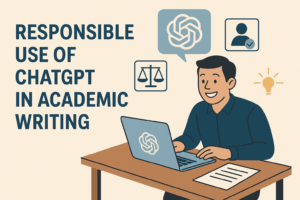Abstract
The integration of generative artificial intelligence (GenAI) tools such as ChatGPT into academic writing has introduced new opportunities and challenges for higher education. This paper explores principles of responsible use, focusing on ethical disclosure, intellectual integrity, data privacy, and equitable access. It also examines emerging institutional responses that promote AI literacy and critical engagement. The responsible use of ChatGPT requires a balance between technological innovation and the preservation of authentic scholarly inquiry.
1. Introduction
The proliferation of large language models (LLMs) like ChatGPT, Claude, and Gemini has significantly transformed how academic writing is conceptualized and produced. These models generate coherent text, summarize complex ideas, and assist with linguistic refinement (Kasneci et al., 2023). Their rapid adoption across universities has prompted both enthusiasm and apprehension, with questions arising about authorship, plagiarism, and intellectual honesty.
While some institutions initially banned AI-assisted writing, the academic community is increasingly recognizing that GenAI tools can enhance learning outcomes when used responsibly. As stated by the UNESCO (2023) Guidance for Generative AI in Education and Research, the key challenge is to ensure that “AI supports human learning rather than replacing it.”
2. Defining Responsible Use in Academic Contexts
2.1 Transparency and Disclosure
Responsible use entails clear acknowledgment of AI contributions. The Committee on Publication Ethics (COPE, 2023)recommends that authors disclose when AI tools have been used for drafting, editing, or idea generation. Failure to do so can obscure the human contribution and compromise the accountability of scholarly work.
Example disclosure statement:
“Sections of this paper were developed with the assistance of OpenAI’s ChatGPT for language refinement and structural feedback. The author reviewed and edited all generated content.”
2.2 Human Oversight and Critical Evaluation
LLMs are prone to “hallucinations” — producing plausible but inaccurate or fabricated information (Ji et al., 2023). Thus, human oversight is essential to validate sources, ensure factual accuracy, and maintain argument coherence. Responsible use positions ChatGPT as a cognitive support system rather than an autonomous author.
2.3 Avoiding Plagiarism and Misattribution
Academic integrity policies globally classify the unacknowledged use of AI-generated text as a form of misconduct (Elsevier, 2024). AI writing must be properly attributed, and students must demonstrate their independent understanding. As Bretag (2019) emphasizes, integrity is not merely rule-following but “a commitment to honesty, trust, and fairness in knowledge creation.”
2.4 Data Privacy and Security
Inputting sensitive or unpublished data into AI tools may breach privacy laws such as the EU’s General Data Protection Regulation (GDPR). Universities now advise against sharing identifiable student records or confidential research content in public LLMs (EDUCAUSE, 2024). Ethical practice requires awareness of data retention policies and provider terms of service.
2.5 Equity and Accessibility
AI tools can democratize access to academic communication by supporting non-native speakers and individuals with disabilities (McGee, 2024). However, disparities in access to paid versions or institutional subscriptions risk widening the digital divide. Responsible AI integration must prioritize inclusivity and institutional support.
3. Institutional and Pedagogical Responses
3.1 From Prohibition to Integration
Early reactions to ChatGPT often centered on restriction and surveillance, with plagiarism detectors like Turnitin incorporating AI-detection modules. However, detection-based approaches are limited by high false positive rates (Liang et al., 2024). Progressive institutions now emphasize AI literacy—embedding ethical AI use, critical evaluation, and citation practices into curricula (University of Sydney, 2024).
3.2 Teaching AI Literacy
Educational frameworks are shifting toward constructive AI pedagogy, where students learn how to use LLMs to refine ideas, generate outlines, and compare perspectives while maintaining academic ownership (Zawacki-Richter et al., 2023). This approach reframes AI as a “collaborative cognitive tool” that enhances critical thinking rather than diminishing it.
4. Discussion
The responsible use of ChatGPT in academic writing lies at the intersection of ethics, pedagogy, and technological fluency. While AI assistance can reduce linguistic barriers and streamline drafting, it must be complemented by human judgment and disclosure. As academic authorship evolves, new forms of collaboration—between human and machine—will redefine scholarly credibility.
Institutions should move from punitive AI policies toward cultivating AI integrity frameworks that combine transparency, accountability, and inclusivity. Future research should explore discipline-specific guidelines and automated transparency markers (e.g., metadata tagging of AI-generated sections).
5. Conclusion
Responsible use of ChatGPT in academic writing is not about restriction but about redefinition. AI should empower scholars to think more clearly, write more accessibly, and collaborate more effectively — while upholding the authenticity of human thought. The academic community must continue developing ethical frameworks that align technological potential with educational values.

